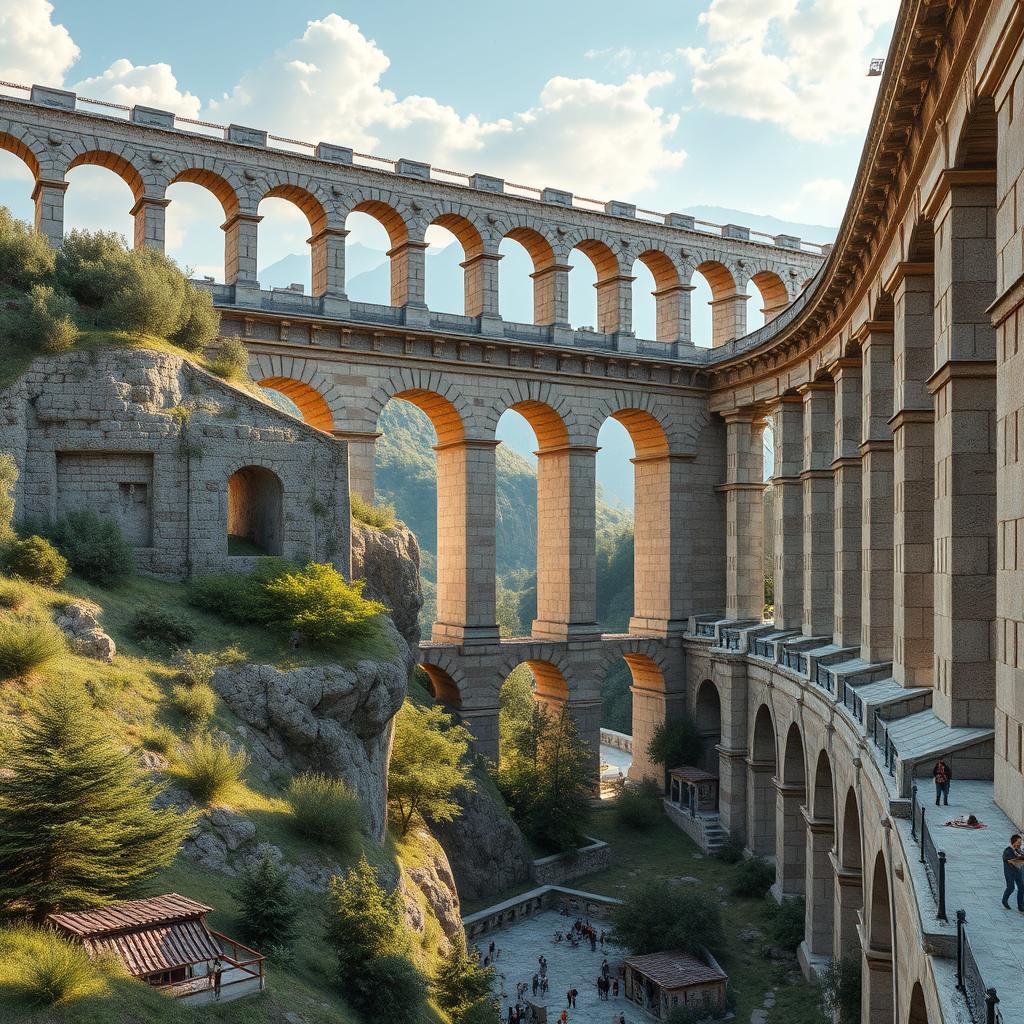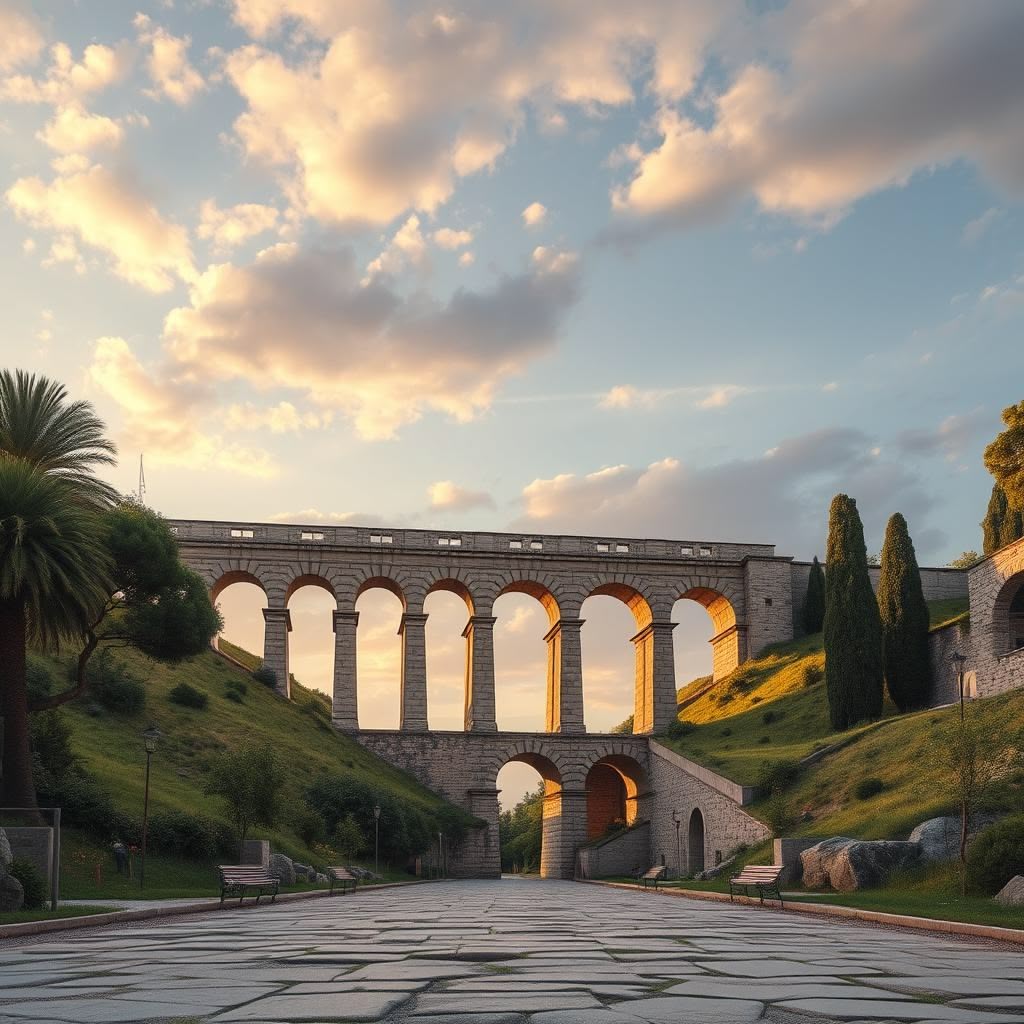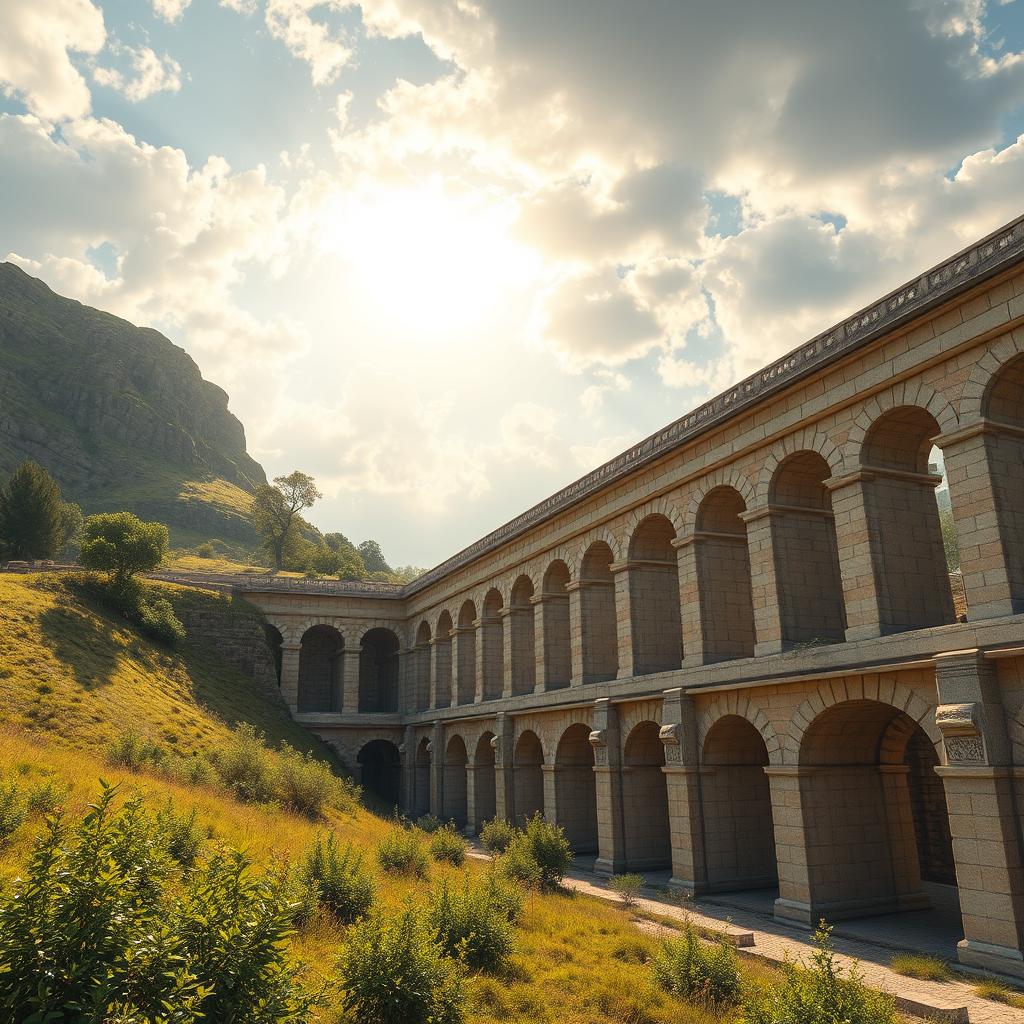What Ancient Romans Knew About Infrastructure That Modern Engineers Have Forgotten
The Genoa Bridge collapse in Italy killed 43 people in 2018 when a section of the Morandi Bridge suddenly gave way during a rainstorm. Built just 51 years earlier, this modern marvel’s catastrophic failure represents an alarming trend. Across America, the American Society of Civil Engineers consistently grades our infrastructure a D+, with over 46,000 bridges deemed structurally deficient. Meanwhile, less than a mile from where the Genoa disaster occurred stands the Ponte di Carignano, a Roman-era bridge that has remained functional for over 2,000 years despite earthquakes, wars, and centuries of continuous use.
This stark contrast isn’t coincidental—it’s a damning indictment of how we’ve abandoned engineering principles that once created structures designed not just for decades, but for millennia. The Romans built the Pantheon, whose unreinforced concrete dome remains the world’s largest nearly 2,000 years after construction. They constructed aqueducts like Pont du Gard that still stand tall after two millennia. They engineered roads so durable that portions remain usable today, long after the empire itself collapsed.
What if our modern infrastructure problems—from crumbling bridges to failing dams—stem not from insufficient technology but from abandoning principles proven over millennia? What if, in our rush toward innovation, we’ve forgotten fundamental truths about building structures meant to last?
The Self-Healing Concrete That Modern Science Couldn’t Replicate Until Now
When MIT materials scientist Admir Masic examined samples of ancient Roman maritime concrete from harbors dating back to 79 CE, he discovered something extraordinary. While modern concrete typically lasts 50-100 years before requiring significant repairs, these Roman structures had survived direct contact with seawater for over 2,000 years. Not only had they survived—they’d gotten stronger.
“It’s remarkable that these ancient structures made with lime and volcanic ash still stand today, especially in aggressive maritime environments where modern Portland cement would deteriorate within decades,” explains Masic. The secret? A process called “hot-mixing” where quicklime was incorporated not fully mixed, leaving reactive particles that would later activate when exposed to water, effectively allowing the concrete to “heal” itself when cracks formed.
This self-healing mechanism remained a mystery until 2023, when Masic’s team finally decoded the process after years of analysis. The Romans weren’t just mixing ingredients—they were designing a material with inherent longevity through deliberate engineering of its microstructure. Today’s engineers, focused on immediate strength and cost-efficiency, designed concrete that’s strong but ultimately fragile compared to its ancient counterpart.
In Houston, the concrete supporting critical highway overpasses requires replacement after just 40-50 years due to constant exposure to water, temperature fluctuations, and weight stress. Meanwhile, Roman harbors at Caesarea and Portus Cosanus remain structurally sound after two millennia of direct seawater exposure—a far more aggressive environment than any Houston highway faces.

Precision Engineering Without Modern Tools: The Roman Aqueduct Marvel
The Pont du Gard aqueduct in southern France stands 160 feet tall, spans nearly 900 feet across a river valley, and maintained a gradient of just 1 inch per 500 feet over its entire 31-mile length. This precision allowed water to flow consistently without stagnation or excessive force—all designed without computers, laser levels, or modern surveying equipment.
Dr. Elena Rodriguez, an archaeological engineer who studied the Pont du Gard extensively, notes: “The Romans achieved a surveying precision that would challenge modern engineers even with today’s technology. They maintained a gradient of 1:3000 across varying terrain—equivalent to a height difference of less than one meter over three kilometers. This level of precision wasn’t accidental but deliberate, showing a profound understanding of hydraulic principles.”
This precision wasn’t achieved through superior technology but through methodical, patient engineering. Roman engineers used simple water levels, groma surveying tools, and consistent validation procedures that prioritized accuracy over speed. They understood that water infrastructure required perfect gradients to function properly over centuries, not just decades.
Compare this to California’s Oroville Dam, which suffered a catastrophic spillway failure in 2017 just 49 years after construction, forcing the evacuation of 188,000 people. The failure’s root cause? Insufficient attention to foundation preparation and drainage—basic principles that Roman engineers would never have compromised on, regardless of schedule or budget pressures.

Road Networks Built to Outlast Empires
The phrase “all roads lead to Rome” reflects more than just the empire’s centralized nature—it acknowledges one of history’s most impressive infrastructure achievements. The Romans built over 250,000 miles of roads across their empire, with 50,000 miles being fully paved highways. Many sections remain intact and usable today, having survived 20 centuries of use, weather, and neglect.
The secret behind this longevity wasn’t just in the materials but in the methodical construction process. Roman roads weren’t simply laid on the ground—they were engineered systems with multiple layers, each serving a specific purpose:
The Roman Road Construction Method
Roman road construction began with excavation to solid ground, sometimes several feet below the surface. Engineers then installed a foundation layer (statumen) of large stones, followed by a layer of crushed rocks and lime mortar (rudus). Above this came a layer of concrete-like material with smaller stones (nucleus), topped with large, tightly-fitted paving stones (summum dorsum). The entire structure included carefully designed drainage systems and regularly spaced maintenance access points.
This multi-layered approach distributed weight, provided drainage, and allowed for thermal expansion—addressing the three primary factors that deteriorate modern roadways. The result? Roads that have outlasted the empire that built them by 1,500 years.
Meanwhile, in Michigan, asphalt roads require significant repairs after just 7-10 years despite modern technology and materials. The difference isn’t capability—it’s philosophy. Roman roads were designed for centuries of use, while modern highways are often designed to meet minimum requirements within constrained budgets.
The Pantheon: Engineering Marvel That Modern Architects Still Study
Standing beneath the Pantheon’s dome in Rome, one can’t help but feel humbled. Nearly 2,000 years after its construction, it remains the world’s largest unreinforced concrete dome—a feat that would be challenging to replicate even with today’s advanced materials and computer modeling.
The dome spans 143 feet without internal supports, tapers from 21 feet thick at the base to just 4 feet at the oculus, and uses increasingly lighter materials as it rises. This sophisticated weight distribution solved structural challenges that modern engineers still marvel at.
“The Pantheon represents perhaps the finest example of concrete engineering in history,” explains structural engineer Robert Mark of Princeton University. “The builders understood the behavior of their materials so thoroughly that they created a perfectly balanced structure where compression forces are distributed ideally throughout the dome. This isn’t just good engineering—it’s engineering genius.”
This masterpiece wasn’t created through trial and error. Roman architects understood mathematical principles of weight distribution, material properties, and structural forces with surprising sophistication. They tested materials extensively and built upon knowledge accumulated across generations.
In stark contrast, the Tacoma Narrows Bridge—built in 1940 with modern materials and engineering calculations—collapsed just four months after completion due to aerodynamic forces that designers had failed to properly account for. The Romans, with their methodical approach to understanding natural forces, might have avoided such a catastrophic oversight.

Before: Our Current Infrastructure Crisis
Today’s infrastructure challenges are well-documented but poorly addressed. The American Society of Civil Engineers estimates the United States needs to spend $4.5 trillion by 2025 just to bring existing infrastructure to acceptable standards. Bridges designed to last 50 years require replacement after 40. Dams built in the mid-20th century show alarming deterioration. Water systems lose 6 billion gallons daily through leaks.
These aren’t primarily funding problems—they’re philosophical ones. We’ve embraced a short-term approach to infrastructure, prioritizing initial cost savings over lifecycle performance. We build to meet immediate needs rather than designing for generational value. We replace rather than restore, rebuild rather than reinforce.
In Boston, the Big Dig infrastructure project famously went from an estimated $2.8 billion to over $15 billion, with concrete tunnel sections beginning to leak before construction was even completed. The project, completed in 2007, has already required hundreds of millions in repairs for problems that shouldn’t exist in a properly engineered system.
After: What Modern Infrastructure Could Be
Imagine infrastructure built not just for decades but for centuries. Bridges designed with redundant systems and self-healing materials. Water systems that improve with age rather than deteriorate. Roads that require maintenance every 50 years instead of every 5 years.
This isn’t fantasy—it’s historical precedent. By incorporating Roman engineering principles, we could transform our approach to infrastructure development:
Self-Healing Materials
Modern adaptations of Roman concrete principles are already showing promise. Researchers at Delft University have developed bioconcrete containing limestone-producing bacteria that activate when cracks form, effectively healing the material automatically. Tests show these concretes can seal cracks up to 0.8mm wide—a capability that could extend infrastructure lifespan by decades while reducing maintenance costs by billions.
Hydrological Precision
The Roman approach to water management—prioritizing natural flow patterns and gravity over energy-intensive pumping—offers lessons for resilient water infrastructure. Cities like Portland, Oregon have begun implementing gravitational water systems inspired by Roman designs, reducing energy consumption while improving reliability during disasters when electrical systems fail.
Lifecycle Design Philosophy
Perhaps most importantly, we can adopt the Roman perspective on timeframes. Roman engineers built for eternity, not election cycles. They understood that quality foundation work, though invisible to the public and more expensive initially, determined a structure’s ultimate lifespan.

The Bridge: Implementing Ancient Wisdom in Modern Contexts
Transitioning from our current approach to a Roman-inspired philosophy doesn’t require abandoning modern technology—it means enhancing it with proven principles:
1. Prioritize Material Science Over Cost Cutting
The Romans tested materials extensively before deployment and optimized mixtures for specific environmental conditions. Similarly, modern engineers can develop region-specific infrastructure materials rather than using one-size-fits-all solutions. The Netherlands has pioneered this approach with their climate-adaptive materials program, developing specific concrete formulations for marine environments based on Roman principles of incorporating local volcanic materials.
2. Design for Maintenance, Not Replacement
Roman structures were designed with maintenance in mind—aqueducts included access points for repairs, and roads featured standardized construction that allowed for section-by-section restoration. Modern infrastructure can incorporate similar principles, with modular components and accessible systems that enable repairs without complete replacement.
3. Build Redundancy Into Critical Systems
Roman aqueducts often followed different routes to the same destination, providing water security if one line failed. Our critical infrastructure—particularly water, energy, and transportation systems—should incorporate similar redundancies, even if they increase initial costs.
4. Value Institutional Knowledge
The Romans maintained detailed records of engineering principles and passed knowledge through rigorous apprenticeship systems. Today’s engineering firms and public works departments can similarly prioritize knowledge transfer across generations of engineers, ensuring that hard-earned lessons aren’t lost with retirements or department changes.
Case Study: The Roman Approach in Action
In 2018, the Dutch city of Rotterdam faced a common infrastructure challenge: replacing aging sea walls that protected the below-sea-level city from flooding. Rather than simply rebuilding with modern materials, engineers partnered with archaeologists to study Roman coastal structures that had withstood North Sea conditions for centuries.
The resulting design incorporated three key Roman principles: layered construction for progressive strength, self-healing concrete formulations, and design that worked with natural forces rather than against them. Though 15% more expensive initially, analysis showed the Roman-inspired design would last at least 250 years—more than double the expected lifespan of conventional approaches—resulting in cost savings of over €300 million when calculated across the full lifecycle.
Project lead engineer Johanna van der Meer explains: “What impressed us most wasn’t just the Romans’ material science, but their integrated thinking. They never separated engineering from environment—they designed systems that worked with natural forces and actually grew stronger with time. That’s the mentality we need to adopt again.”
Moving Forward: Reclaiming Our Infrastructure Legacy
The contrast between Roman and modern infrastructure isn’t just about historical curiosity—it represents a critical choice for our society. Will we continue building disposable infrastructure, constantly replacing systems that fail prematurely? Or will we reclaim the long-term thinking that once created structures capable of serving civilization for millennia?
The principles are clear:
Material Excellence
Invest in developing and testing materials specifically designed for longevity, even when they increase initial costs. Prioritize lifecycle performance over immediate savings.
Precision Engineering
Embrace the meticulous approach that Roman engineers applied to gradient, alignment, and structural design. Resist the urge to cut corners on invisible but critical foundation elements.
Systems Thinking
Design infrastructure as integrated systems rather than isolated components, considering how structures interact with natural forces and surrounding environments.
Generational Perspective
Perhaps most importantly, we must shift our timeframe—designing not just for the next decade but for our grandchildren’s grandchildren. The Romans built knowing that their work would serve generations yet unborn. This perspective transforms how we approach every aspect of infrastructure development.
We have advantages the Romans could never have imagined—advanced materials science, computer modeling, precision manufacturing. Combined with their philosophical approach to building, we could create infrastructure surpassing anything in human history.
The question isn’t whether we can afford to build infrastructure like the Romans—it’s whether we can afford not to.
Learn How Modern Engineers Are Applying Roman Principles Today
We’re developing a comprehensive case study on successful modern applications of Roman engineering principles in today’s infrastructure projects. This research will show exactly how companies and municipalities are achieving extraordinary results by combining ancient wisdom with modern technology.
Subscribe to our newsletter to receive this case study when published and join a growing movement of forward-thinking engineers, city planners, and infrastructure developers who are building not just for today, but for centuries to come. Enter your email below to be among the first to receive this valuable resource.

